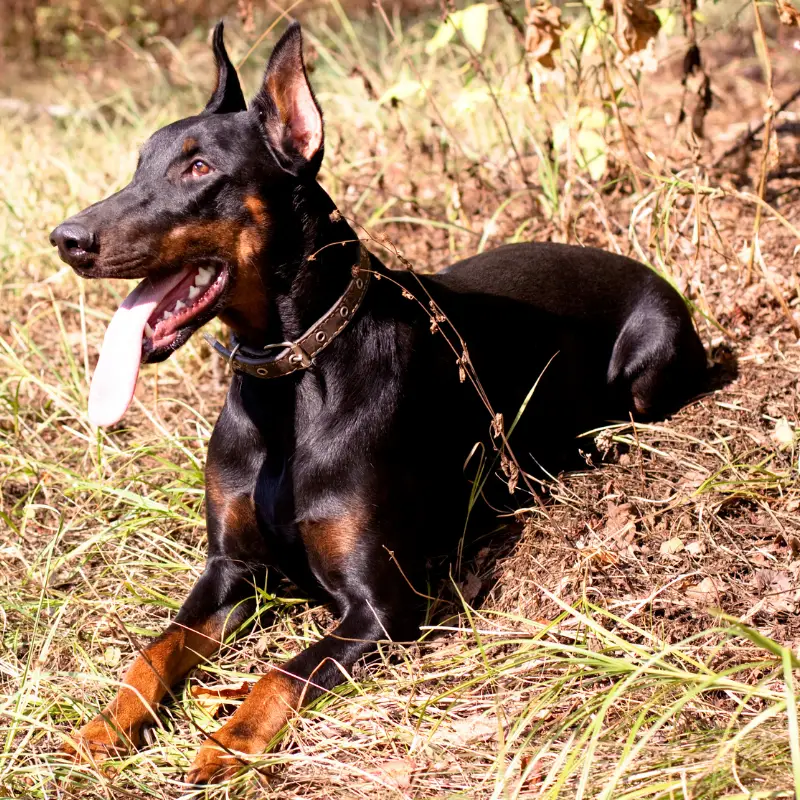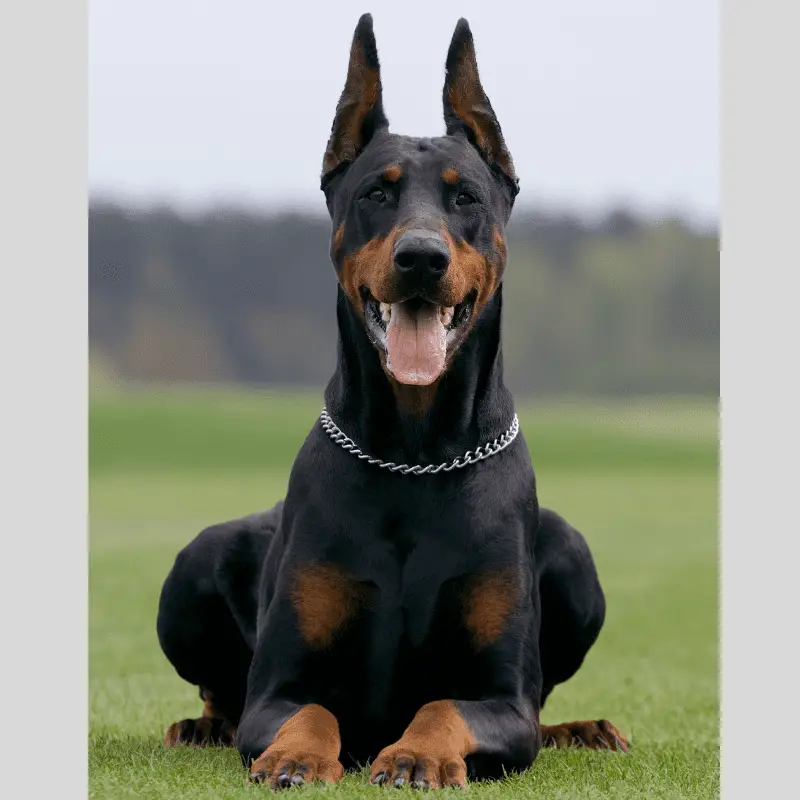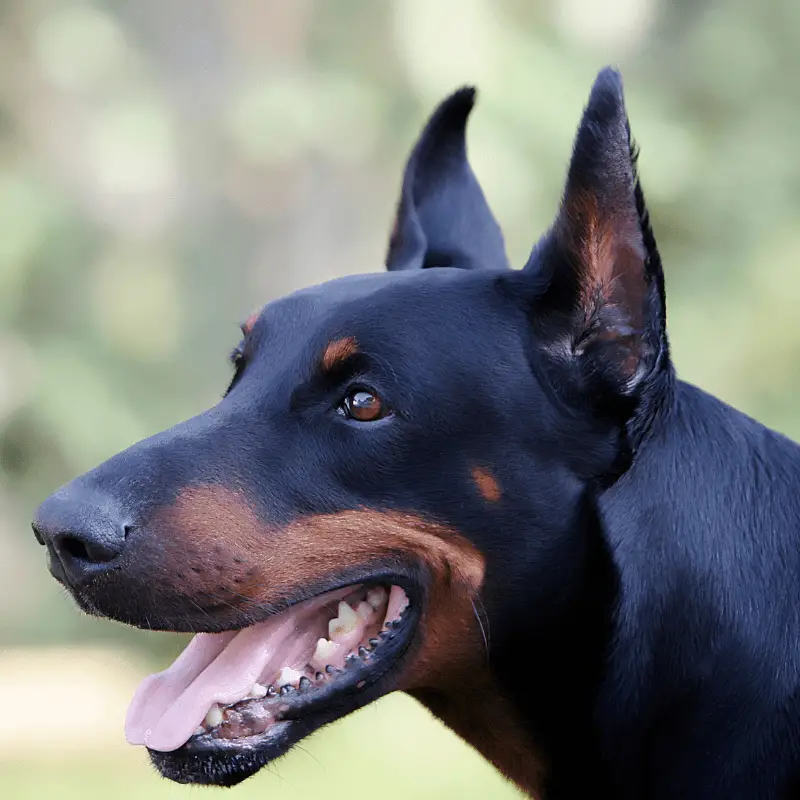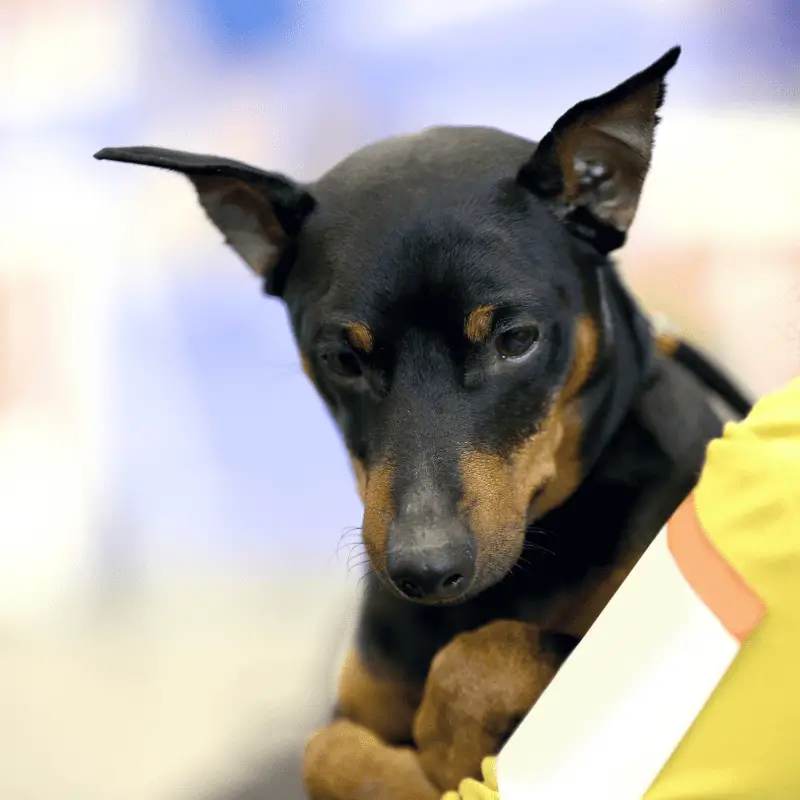Dobermann is one of the highly energetic working dogs originating from Germany in the late 19th century. Even though the exact ancestry of this dog breed is unknown, the experts believe that this breed is a mixture of many different dog breeds.
These dog breeds of possibilities are the old Black and Tan Terrier, Rottweiler, Weimaraner, old German Shepherd and the German Pinscher.
These dogs were bred as guard dogs. The athletic build, thick and smooth coat, and magnificent physique give these dogs an aristocratic look. These intelligent dogs are heavily employed in the police and military force and participate in various canine sports. These dogs can also be great family companions and guardians.
Breed Overview:
- Dog Breed Group: Working Dog
- Height: 24-28 inches
- Weight: 60-100 pounds
- Life Span: 10 to 12 years
- Origin: Germany
- Common nicknames: Dobie
- Named: Dobermann in Europe
- Named: Doberman Pinscher in the United States and Canada
What’s the difference between a Dobermann and a Doberman Pinscher?
Despite the slight differences between these two varieties, they are the same breed of dog. The Doberman Pinscher is bred to the AKC standard, which has been refined for the consumer. However, the European Dobermanns are explicitly bred to the international standard of the Federation Cynologique Internationale (FCI).


Main Differences between the European Dobermann and the American Doberman Pinscher
The main differences between them are the breeding purposes of each dog from the different parts of the world. European dogs are mainly bred as working guard dogs, and the American Doberman Pinscher is bred for the consumer and show rings.
American Doberman Pinscher is for the show ring, so it is more elegant. European Dobermanns are more muscular and have a broader head and a stronger jaw. American Doberman Pinscher has a slightly more sensitive temperament and less protection drive than the European Dobermann’s, and the head is smaller, along with the neck being thinner. The shoulders to the neck have more than an angle compared to the gradual rise of the European Dobermanns. European Dobermanns must not have any white markings. However, the American Doberman Pinscher can have in small areas.
Breed Characteristics
Dobermanns are known for their devotion and loyalty to their owners. These skilful and extremely versatile dogs are always staying alert and watchful to their surroundings. These dogs are great family dogs and love to be a part of the household. You can train your Dobermann to participate in almost all the household chores. Even though these dogs appreciate a fenced backyard for running, playing, exercising, and having fun with the family, they are not the typical backyard dog. As these dogs are very energetic and active, you will have to plan a lot of exercise and activity to keep them engaged.
When socialised and appropriately trained, Dobermanns can develop a very stable personality. These intelligent dogs are, by nature, very driven. They know what they want and how they can get that. As they have a stubborn streak, these dogs can create significant problems for any owner without proper leadership.
As these dogs were bred as guard dogs, they have an innate dominating ability. So, if the owner does not establish themselves as the pack leader, it will be harder for them to deal with their pet Dobermann in certain situations. As the dog owner, you have to be consistent yet firm while dealing with your pet. These dogs have keen intelligence and have a constant need for stimulation. They also need proper care and commitment from their owners to stay happy.
So, to keep your Dobermann engaged and happy, you have to give them both physical and mental stimulation. These dogs love their owners and value their love and attention. They are also experts in returning the affection their owners shower on them. That’s what makes Dobermann a family dog. Dobermann is an easy-going breed and also gets on well with children and other pets.
Dobermanns are very versatile, from being the protector to family-loving dogs and getting along with other pets.
Bark
As these dogs are primarily bred as guard dogs, they have a natural tendency to bark. If the owners do not control the inappropriate barking behaviour, things can get out of hand. As these dogs continuously require adventure and activity, they can become destructive when and if bored. These dogs also have great instincts. They can predict potential dangers, which go great with their natural protective tendencies.
When do Dobermanns grow up?
For these dogs, maturity comes quite late. They keep on displaying puppylike traits till they are 3 to 4 years old.
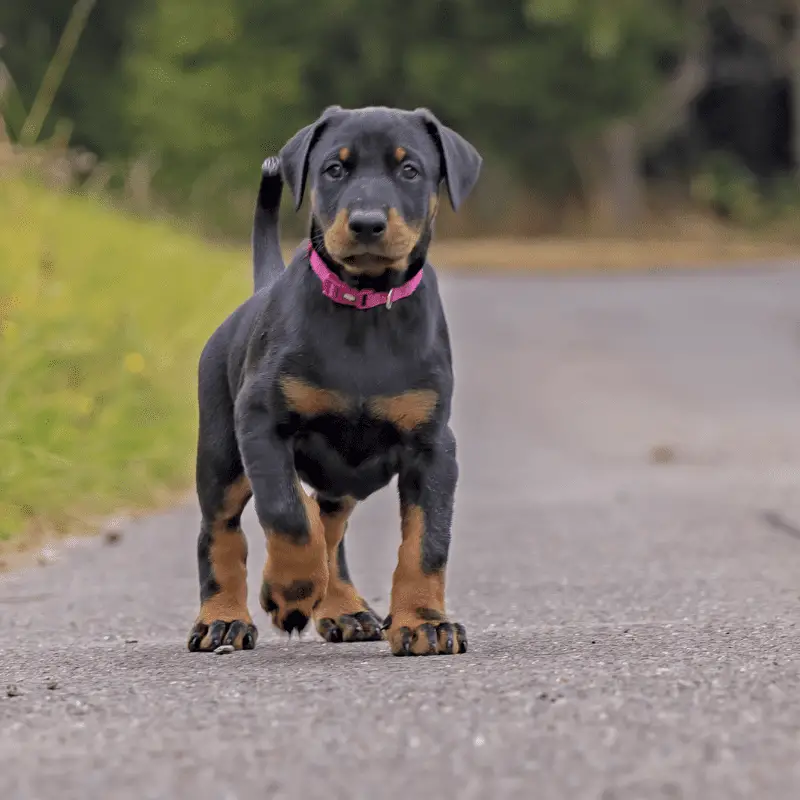
Temperament
As these dogs are intelligent and intensely loyal and were bred as guard dogs, the Dobermanns aggressiveness and intimidating characters were significantly valued by the Europeans. However, thanks to years of careful breeding, the breeders have reshaped the temperament of the Dobermann. Especially in America, the same breed called the Doberman Pinscher has had a makeover to be less muscular, more sensitive and in touch with human feelings, along with a less threatening look about them.
Even though the Dobermanns breed of Europe looks and acts ferocious, Dobermanns show way less aggression than the other dogs, like a Chihuahua or a Dalmatian. It is, however, very natural for the Dobermanns to show aggressiveness towards other animals or humans if they feel that their human companions are under any threat. However, they are not one of the breeds that act aggressively. These dogs are gentle and never go looking for trouble.
- Alert
- Assertive
- Intelligent
- Loving
- Loyal
- Protective – Slightly less for the American Doberman Pinscher
Appearance
It is impossible to confuse Dobermanns or a Doberman Pinscher with any other dog breed. Slender, powerful, and athletic, these dogs have an exquisite physique that is recognisable instantly. As European Dobermanns were bred as guard dogs, the male Dobermanns have a solid muscular build. Even though the females are slender compared to the males, they also have robust bodies.
Size and Proportions
The breed standards of the Dobermann vary depending on the breed clubs and kennel. Most of the breeders follow the criteria provided by the Federation Cynologique Internationale (FCI). Unlike the refine Doberman Pinscher, it is bred to the AKC standard.
The standard male European Dobermanns have a height of 26-28 inches. The female dogs sort about 24-26 inches in height. These dogs have square-shaped bodies. Their height and length are proportional. The head, legs, and shoulders are also balanced to their body, giving these dogs such a regal appearance. The standard weight of the dogs ranges between 70-100 pounds.
Coat Color
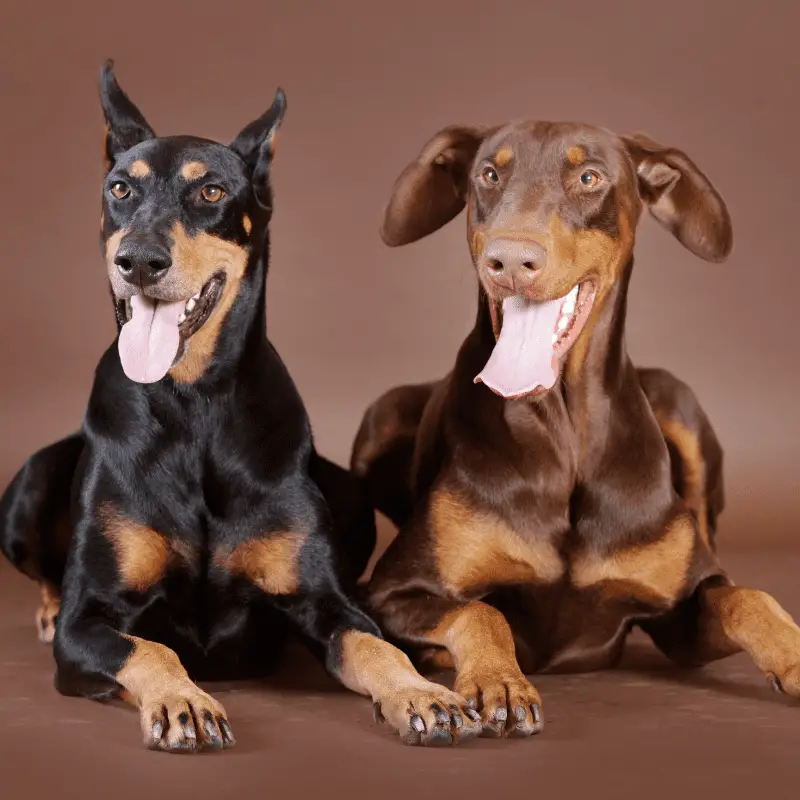
The Dobermann has a smooth, sleek, and short coat that stays close to their skin. Some dogs may have a slight undercoat around their neck regions. Most of the Dobermann dogs come in red, black, fawn, and blue colours. Dobermanns can also have rust-coloured markings above the eyes, on their muzzles, chest, and throat. The same kind of markings can also be seen on their feet and legs. These dogs have dark eyes and piercing gazes.
Tail
The natural tail size of the Dobermann is long. However, most of the departments sport short tails due to docking. It is a surgical procedure where the extended portion of the tail is surgically removed are birth.
Docking
The practise of docking has been here for centuries. It is even older than the Dobermann breed itself. Previously, breeders docked the dogs mainly to make sure that the tail does not get in the way of the dog’s work.
However, the practice of docking was always controversial. Nowadays, both FCI and IDC have put the docking out of the breed standard. Docking for all dogs has been banned in the UK for several years. Now, docking is illegal for native-born dogs as well.
If docking is due to a medical emergency, the owners need to possess a veterinary certificate to avoid prosecution.
In many other European countries, docking has also been illegal for some time now. Recently, Australia has also declared docking an illicit affair. The American Kennel Club standard for Doberman Pinschers includes docking of the tail near the second vertebrae. Docking is a common practice in countries like Russia, the United States, and Japan.

Ears
Traditionally, the ears of the Dobermann have been cropped. The ears of the Dobermann are not naturally pointed and erected but are relaxed and floppy. The supporters of this practice argue that cropping helps these dogs detect the sound better while working. However, both cropping, as well as docking are controversial practices.
The American Veterinary Medical Association experts opinion is that these practices are conducted for cosmetic reasons and do not have any proven health benefits on the dogs. These procedures can be painful for the puppy. Several countries, including the United Kingdom and Australia, have outlawed cosmetic cropping along with docking. However, some other countries, like the USA, are still following this practice.
Trainability
As these dogs are keenly intelligent, they can learn things quite quickly. That is what makes the training process of the Dobermann very easy. Due to their dominant nature, the dog tends to assume the alpha leader of the pack. The owners should be cautious about this authoritarian tendency and treat these dogs firmly and consistently to make them understand who the alpha is. If you can claim your place as the alpha, there will be no problems with the behaviour of a Dobermann.
History
Even though the official story of the origin of Dobermann is a bit murky, the most common origin story starts from the 1880s with a tax collector named Karl Friedrich Louis Dobermann. He was also a tax collector of Apolda, Germany. Dobermann was a dog breeder who ran the Apolda dog pound. He wanted to breed a guard dog that could protect him and the money from the bandits as he completed his rounds. With this idea in mind, Dobermann started to mix dog breeds of a cocktail of strength to create a fiercely loyal dog that is also intelligent and protective.
The Doberman Pinscher Club of America pointed out that there are no solid leads about exactly which dog breeds he mixed to create the Dobermann dogs. However, it is a well-accepted fact that the two German dog breeds have played significant roles in developing the Dobermann dog breed. These two breeds are now extinct old German Shepherd and the German Pinscher. It is believed that these two breeds are also the ancestors of the Weimaraner and Rottweiler dogs.
While previously these dogs were known as the Doberman Pinscher, in the 1940s, Germany dropped the latter part of the name. Upon the death of Karl Friedrich Louis Dobermann, German authorities named the dog breed after him. They explained that the term pinscher, which means terrier in German, does not describe the breed anymore. After the Germans dropped the Pinscher, the rest of the countries followed suit, except for America. America and Canada are perhaps the only places where the dog is known as the Doberman Pinscher still. Although the American Doberman Pinscher breed has changed from the standard Dobermann, they kept the original name.
If you are interested to learn more about the history of the Doberman? Here is a well-documented and easy to read history timeline of the Dobermann, which dates from the 1870s to the modern day.
Health
Even though Dobermanns are primarily healthy, like most other dog breeds, they are prone to specific health issues. The owners should be aware of these health concerns to keep their dogs healthy for a long time.
Von Willebrand’s Disease
It is a bleeding disorder that interferes with the natural blood clotting ability of the Dobermann. The main symptom of this disease is severe bleeding after your pets suffer an injury. Bleeding gums, nose bleed, bleeding in the intestine or stomach are other symptoms of this problem. There is no direct treatment of this disease. Transfusion from normal Dobermann dogs is generally used for treating the suffering dogs. Most Dobermann dogs suffering from this problem can lead an everyday life. However, it would be best to breed these dogs that have this disease as it’s hereditary.
Progressive Retinal Atrophy
It is a hereditary disease that affects the retina. The Dobermann dog suffering from this problem gradually becomes night blind. The deterioration of the retina is slow. That is why with the ongoing progression of the disease, the dog loses his eyesight during the daytime. Most dogs can adapt well to their lost or limited vision as long as they remain in the same place as before.
Hip Dysplasia
It is also a hereditary problem where the thigh bone of the dog does not fit to the hip joints properly. This problem can cause severe pain and can reduce the mobility of the dogs significantly. However, some dogs may not show any outward discomfort. An X-ray screening is the best way to find out if your dog is suffering from this problem. Do not use the dogs who are suffering from this problem for breeding.
Arthritis
Dobermanns can develop arthritis as they become old.
Hypothyroidism
Hypothyroidism is a problem that is developed due to insufficient thyroxine production. This hormone is responsible for managing the metabolism of Dobermann dogs. The dog suffering from hypothyroidism shows the following clinical signs, such as weight gain, hair and muscle loss, and lethargy. This disease is diagnosed through blood tests and can be cured through hormone replacement therapy.
Albinism
Albinism in Dobermanns is associated with several health issues, like skin cancer, immunological problems, liver and kidney issues, retinal abnormalities, and photosensitivity. Genetic mutations are the root cause of this problem. That is why the cream or white-coloured Dobermanns should not be bred. The prospective owners should be aware of these issues and should not get lured by unethical breeders.
Care
Even though Dobermanns can live happily in an apartment, country homes with space are best suited for them. These dogs need a lot of physical and mental exercise to remain healthy and happy. These requirements can get a bit tiring to the owners who are not up to the job. Do not leave your pet Dobermann alone for an extended period.
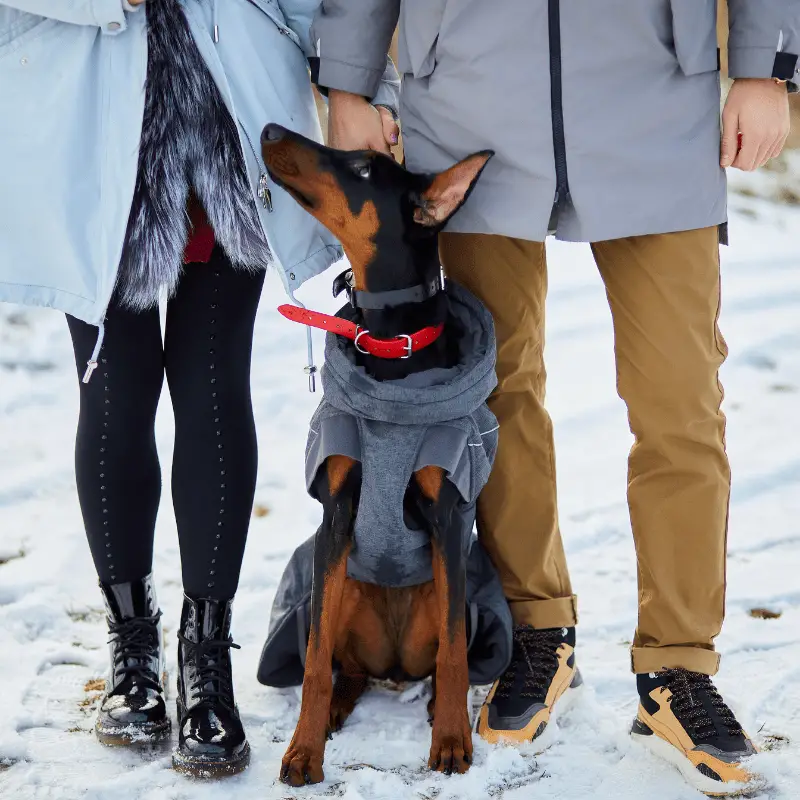
Understand that the Dobermanns are not backyard dogs either. Keeping these dogs chained is not a solution either. They want and should be a part of the family, taking part in all family activities. Early socialisation and training are vital for a happy Dobermann. Otherwise, these dogs can grow up as quite quarrelsome pets.
Feeding
How much you should feed your dog depends on its size, build, age, metabolism, and level of activity. Dogs, like their human counterparts, are individual animals. All of them do not need the same amount of food. The dog food quality also makes a difference in portion control. Measure the food of the Dobermann before dishing it out. It will help you to control the portion of the food. Consult with veterinary professionals to understand whether the food you are offering to your dog is enough.
Fun Facts
- In World War II, the United States Marine Corps chose a Dobermann as their official war dog. The breed extensively served in both the European as well as Pacific areas of operations. 25 Dobermanns are buried at the War Dog Memorial At Naval Station Guam.
- Dobermanns have appeared on television and in films several times.
- Despite their physical similarities, the miniature Pinscher is not related to the mini Doberman Pinscher

